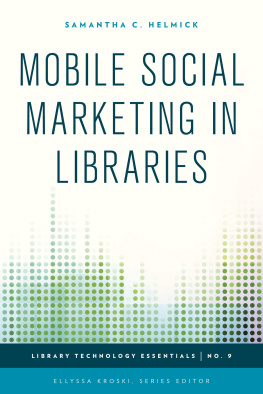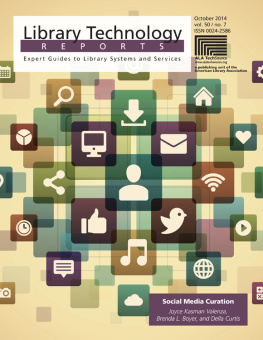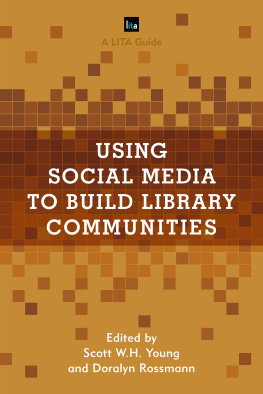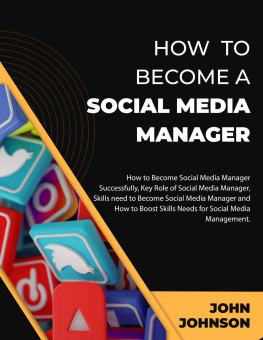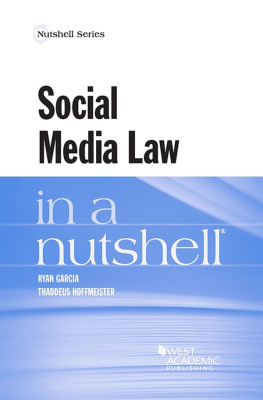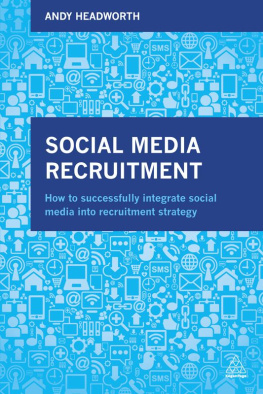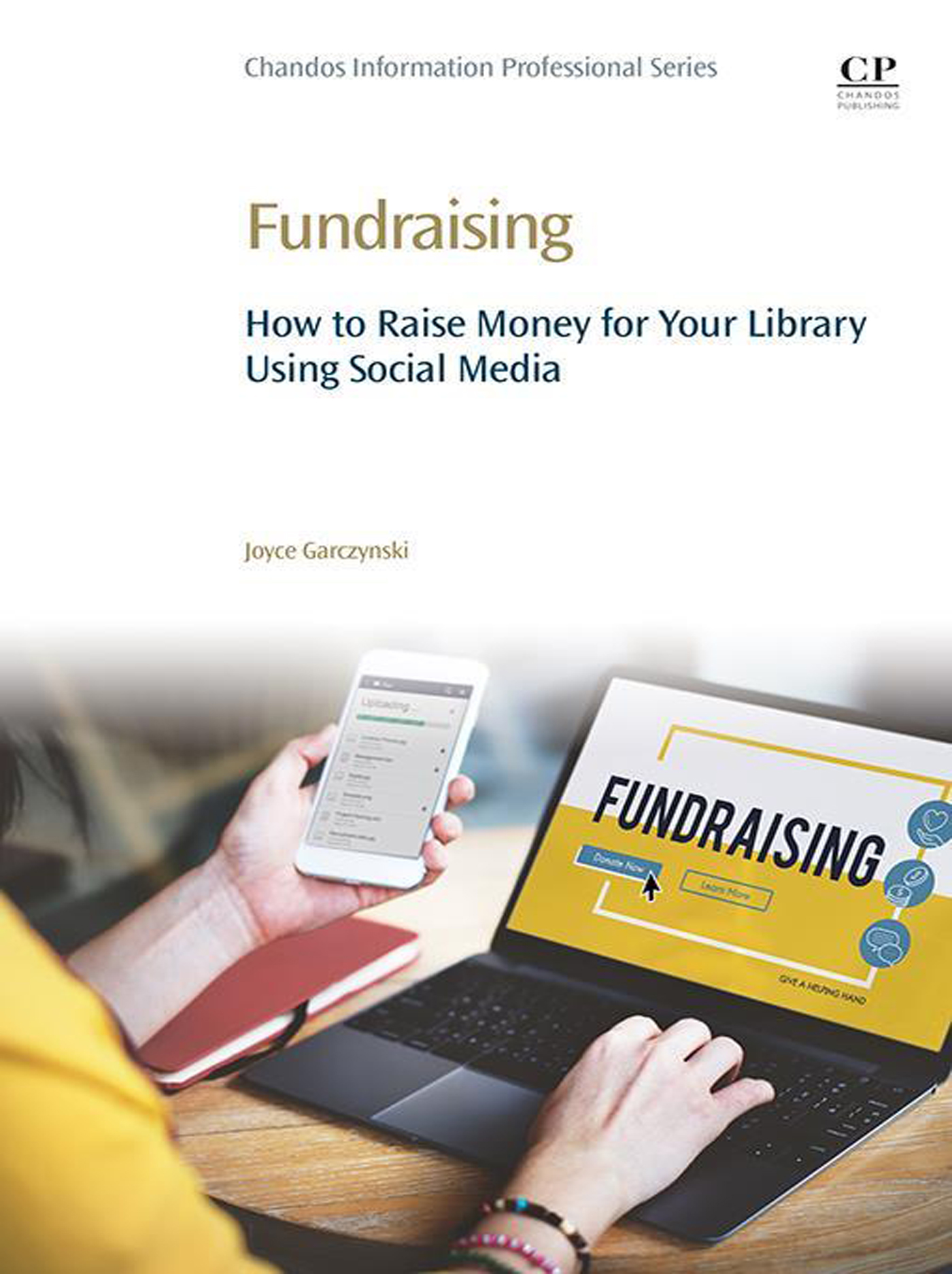Table of Contents
Landmarks
Table of Contents
Fundraising
How to Raise Money for Your Library Using Social Media
Joyce V. Garczynski
Chandos Information Professional Series

Copyright
Chandos Publishing is an imprint of Elsevier
50 Hampshire Street, 5th Floor, Cambridge, MA 02139, United States
The Boulevard, Langford Lane, Kidlington, OX5 1GB, United Kingdom
Copyright 2018 Joyce V. Garczynski. Published by Elsevier Ltd. All rights reserved.
No part of this publication may be reproduced or transmitted in any form or by any means, electronic or mechanical, including photocopying, recording, or any information storage and retrieval system, without permission in writing from the publisher. Details on how to seek permission, further information about the Publishers permissions policies and our arrangements with organizations such as the Copyright Clearance Center and the Copyright Licensing Agency, can be found at our website: www.elsevier.com/permissions.
This book and the individual contributions contained in it are protected under copyright by the Publisher (other than as may be noted herein).
Notices
Knowledge and best practice in this field are constantly changing. As new research and experience broaden our understanding, changes in research methods, professional practices, or medical treatment may become necessary.
Practitioners and researchers must always rely on their own experience and knowledge in evaluating and using any information, methods, compounds, or experiments described herein. In using such information or methods they should be mindful of their own safety and the safety of others, including parties for whom they have a professional responsibility.
To the fullest extent of the law, neither the Publisher nor the authors, contributors, or editors, assume any liability for any injury and/or damage to persons or property as a matter of products liability, negligence or otherwise, or from any use or operation of any methods, products, instructions, or ideas contained in the material herein.
British Library Cataloguing-in-Publication Data
A catalogue record for this book is available from the British Library
Library of Congress Cataloging-in-Publication Data
A catalog record for this book is available from the Library of Congress
ISBN: 978-0-08-102003-6 (print)
ISBN: 978-0-08-102004-3 (online)
For information on all Chandos Publishing publications visit our website at https://www.elsevier.com/books-and-journals

Publisher: Jonathan Simpson
Acquisition Editor: Glyn Jones
Editorial Project Manager: Andrae Akeh
Production Project Manager: Surya Narayanan Jayachandran
Senior Designer: Greg Harris
Typeset by MPS Limited, Chennai, India
Chapter 1
Why Should Libraries Use Social Media to Fundraise?
Abstract
While fundraising on social media may have some critics, this chapter will examine why libraries need to raise money from individuals and why they should pursue fundraising on social media channels. In an era of stagnant or even decreasing budgets, libraries need to explore new ways to reach individual donors and social media can provide a mechanism for libraries to build and maintain a relationship with donors, especially those from Generation X and the Millennial generation. As outlined in this chapter, when libraries look at the fundraising process holistically and seek to build a community with donors and potential donors before asking for money, social media fundraising can flourish.
Keywords
Fundraising; social media; Millennials; Generation X; Baby Boom generation
When I was growing up, one of my earliest memories was of my mother encouraging me to be patient. I was 4 and wanted to be a grown-up, stay up late, and eat ice cream for dinner but my mom reminded me of the old adage that Rome wasnt built in a day (, p. 42), and my adult life similarly needed time and the wisdom that comes with seeing the bigger picture to blossom.
Fast forward over 30 years later and here I am in my new role as the librarian in charge of my librarys social media and library fundraising. I have a background in communication so I had taken control of the librarys social media when I first arrived at this library in 2009, but now my boss had designated fundraising to be half of my job. In addition, we had new university leadership who were very interested in increasing the amount of money the library and other units on campus brought in. Basically, I wanted to raise money for the library and raise it quickly in order to demonstrate my success in my new role, but I kept hearing my mothers sage advice in my head to be patient. I needed to take my time and get to know the fundraising landscape at my institution and within the broader nonprofit world. I also needed to figure out how I could take the skills and knowledge that I did have in communication and social media and apply them to help me be successful in order to see my new career blossom.
One of the first things I did when I anticipated that fundraising would play a bigger role in my duties was to survey the academic library fundraising landscape. Specifically I wanted to know what the recommended practices for libraries fundraising on social media and whether or not academic libraries were following those practices. I first searched the library literature for best practices and did not find any, so I then looked at the nonprofit fundraising literature and found copious suggestions for how to fundraise using social media. Then I conducted a content analysis of 276 posts on the social media accounts of 16 academic libraries to determine to what extent they followed the best practices most prevalent in the nonprofit literature (). Given the lack of information on how libraries could use social media to fundraise, I decided to read all I could that was related, experiment, and then share the results in this book. I hope that reading this first chapter and ultimately this book will persuade and ultimately inspire other library social media managers to attempt to fundraise using their platforms and other library fundraisers to explore using social media channels to bring in donations.
Why Do Libraries Need to Fundraise?
From serving as the information repository of kings to teaching those who are homeless how to read, libraries have a history providing valuable resources to their communities (). Thus, it has become more the rule than the exception for libraries to face flat or even decreased budgets.
In response to these financial challenges, many libraries have begun to focus on advocacy and communicating their value to supporters and administrators. The ). This is a significant first step in libraries fundraising efforts because being able to articulate the value of libraries, specifically the value of the library trying to raise the money, is necessary in order to successfully fundraise.
Libraries have typically employed these advocacy tools and others in order to fundraise in three specific spheres. They have advocated for additional funding or the restoration of funding from the larger government, corporate, or educational entity that oversees them; they have applied for foundation, government, or corporate grants; and/or they have attempted to raise money from individuals. The library literature contains a plethora of theoretical and practical approaches related to the first two spheres, but much less is known about the third. For example, a search in Google Scholar for library advocacy yielded 631,000 results and a search for library grants yielded 1,400.000 results, but a Google Scholar search for library fundraising, however, produced only 74,300 results (). Because of this gap in the library literature, this text will explore how libraries can craft and deploy messages on social media platforms in order to raise money from individual donors to help meet the demands imposed by shrinking or stagnant library budgets.





